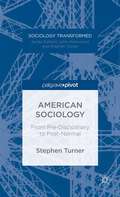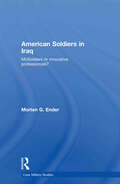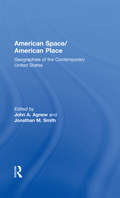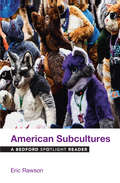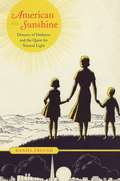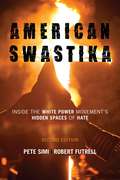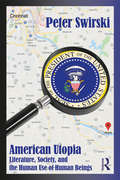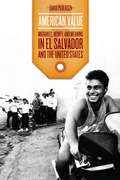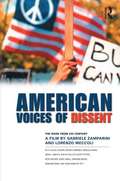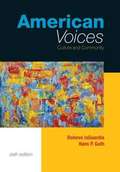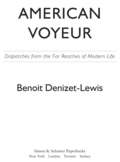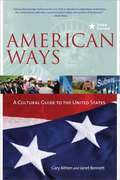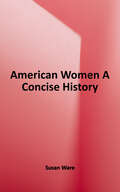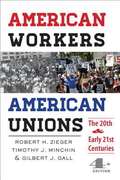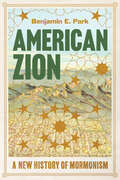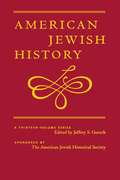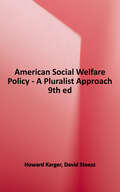- Table View
- List View
American Sociology: From Pre-Disciplinary to Post-Normal
by Stephen TurnerAmerican Sociology has changed radically since 1945. This volume traces these changes to the present, with special emphasis on the feminization of sociology and the decline of the science ideal as well as the challenges sociology faces in the new environment for universities.
American Soldiers in Iraq: McSoldiers or Innovative Professionals? (Cass Military Studies)
by Morten G. EnderAmerican Soldiers in Iraq offers a unique snapshot of American soldiers in Iraq, analyzing their collective narratives in relation to the military sociology tradition. Grounded in a century-long tradition of sociology offering a window into the world of American soldiers, this volume serves as a voice for their experience. It provides the reader with both a generalized and a deep view into a major social institution in American society and its relative constituents-the military and soldiers-during a war. In so doing, the book gives a backstage insight into the U.S. military and into the experiences and attitudes of soldiers during their most extreme undertaking-a forward deployment in Iraq while hostilities are intense. The author triangulates qualitative and quantitative field data collected while residing with soldiers in Iraq, comparing and contrasting various groups from officers to enlisted soldiers, as well as topics such as boredom, morale, preparation for war, day-to-day life in Iraq, attitudes, women soldiers, communication with the home-front, "McDonaldization" of the force, civil-military fusion, the long-term impact of war, and, finally, the socio-demographics of fatalities. The heart of American Soldiers in Iraq captures the experiences of American soldiers deployed to Operation Iraqi Freedom at the height of the conflict in a way unprecedented in the literature to date. This book will be essential reading for students of military studies, sociology, American politics and the Iraq War, as well as being of much interest to informed general readers.
American Space/American Place: Geographies of the Contemporary United States
by John A. Agnew Jonathan M. SmithAmerican Space/American Place offers geographical perspectives on the condition of the United States at the outset of the twenty-first century. It compares the American ideal of liberty, equality, individual opportunity and social improvement with the contemporary condition of the regions, states and localities--the ideal American space with its reality as a place. It uses the public standard provided by the official ideology of the United States to see how well things are really going. Agnew and Smith consider the contrast between ideal and reality at local, state and national levels in education, health, and welfare, in community, race, gender, and calss relations, in economic and industrial development, and in the use and exploitation of America's landscape. American Space/American Place provides a series of compelling insights into the current condition of American Society, its natural environment and its place within the world.
American Sports: An Anthropological Approach (Sport in the Global Society)
by Boria Majumdar J. A. Mangan Mark DyresonThis collection illustrates the expansiveness of an interdisciplinary approach to the study of sport. While rooted in anthropology, these essays consider American sports in their social, economic, cultural and political aspects, charting their evolution. The book draws from history, sociology, and political science; as well as considering the relationship between the developed and developing world; and culture and masculinity. The first part of the book considers the local and global interplay of professional baseball, covering: Major League Baseball’s impact on the Dominican Republic nationalism and baseball on the Mexican/US border the globalizing forces of baseball as an industry. The second part of the book is concerned with the cultural examination of the responsiveness of masculinity to social and cultural forces, examining: the exaggerated world of bodybuilders in Southern California the cross-cultural comparisons of male behaviour on a bi-national baseball team in Mexico the historical examination of Jews in American sport. This book was previously published as a special issue of Sport in Society
American Subcultures: A Bedford Spotlight Reader
by Eric RawsonAlthough its subject is American society, this book offers a collection of texts that will stimulate critical thinking and frame opportunities for meaningful writing in general. American Subcultures provides you with several exciting opportunities: to develop a sound writing process appropriate to the argumentative and analytical nature of academic writing; to learn critical thinking and reading skills; to investigate and express personal values; and to master interdisciplinary and versatile forms of written communication. The design of this book is predicated on the notion that good writers, like good students, are made, not born. There is nothing innate about the ability to write well. Strong writing — or academic success in general — results from dedication, curiosity, engagement, and effort. Writing can — and should — be a means of discovery, of generating knowledge, rather than merely an instrument for repackaging and disseminating information. We write to learn rather than merely learn to write.
American Sunshine: Diseases of Darkness and the Quest for Natural Light
by Daniel FreundIn the second half of the nineteenth century, American cities began to go dark. Hulking new buildings overspread blocks, pollution obscured the skies, and glass and smog screened out the health-giving rays of the sun. Doctors fed anxities about these new conditions with claims about a rising tide of the "diseases of darkness," especially rickets and tuberculosis. In American Sunshine, Daniel Freund tracks the obsession with sunlight from those bleak days into the twentieth century. Before long, social reformers, medical professionals, scientists, and a growing nudist movement proffered remedies for America’s new dark age. Architects, city planners, and politicians made access to sunlight central to public housing and public health. and entrepreneurs, dairymen, and tourism boosters transformed the pursuit of sunlight and its effects into a commodity. Within this historical context, Freund sheds light on important questions about the commodification of health and nature and makes an original contribution to the histories of cities, consumerism, the environment, and medicine.
American Swastika: Inside the White Power Movement's Hidden Spaces of Hate (Violence Prevention and Policy)
by Pete Simi Robert FutrellThis second edition of the acclaimed American Swastika provides an up-to-date perspective on the white power movement in America. The book takes readers through hidden enclaves of hate, exploring how white supremacy movements thrive nationwide and how we can work to prevent future violence. Filled with powerful case studies, interviews, and first-person accounts, the book explains the differences between various hate groups, then shows how white supremacy groups cultivate their membership through Aryan homes, parties, rituals, music festivals, and online propaganda. <p><p> Featuring updated statistics and examples throughout, the second edition of American Swastika describes most of today’s active white power groups and the legacy of recently disbanded groups. It also discusses new players in the world of white power websites and music and shares new research on how people exit hate groups. As recent events have made clear that the idea of a “post–racial America” is a myth, American Swastika is essential reading for understanding both how hate builds and how we can work to prevent violence.
American Tax Resisters
by Romain D. Huret"The American taxpayer"--angered by government waste and satisfied only with spending cuts--has preoccupied elected officials and political commentators since the Reagan Revolution. But resistance to progressive taxation has older, deeper roots. American Tax Resisters presents the full history of the American anti-tax movement that has defended the pursuit of limited taxes on wealth and battled efforts to secure social justice through income redistribution for the past 150 years. From the Tea Party to the Koch brothers, the major players in today's anti-tax crusade emerge in Romain Huret's account as the heirs of a formidable--and far from ephemeral--political movement. Diverse coalitions of Americans have rallied around the flag of tax opposition since the Civil War, their grievances fueled by a determination to defend private life against government intrusion and a steadfast belief in the economic benefits and just rewards of untaxed income. Local tax resisters were actively mobilized by business and corporate interests throughout the early twentieth century, undeterred by such setbacks as the Sixteenth Amendment establishing a federal income tax. Zealously petitioning Congress and chipping at the edges of progressive tax policies, they bequeathed hard-won experience to younger generations of conservatives in their pursuit of laissez-faire capitalism. Capturing the decisive moments in U. S. history when tax resisters convinced a majority of Americans to join their crusade, Romain Huret explains how a once marginal ideology became mainstream, elevating economic success and individual entrepreneurialism over social sacrifice and solidarity.
American Urban Form
by Sam Bass Warner Andrew H. WhittemoreAmerican urban form--the spaces, places, and boundaries that define city life--has been evolving since the first settlements of colonial days. The changing patterns of houses, buildings, streets, parks, pipes and wires, wharves, railroads, highways, and airports reflect changing patterns of the social, political, and economic processes that shape the city. In this book, Sam Bass Warner and Andrew Whittemore map more than three hundred years of the American city through the evolution of urban form. They do this by offering an illustrated history of "the City"--a hypothetical city that exemplifies the American city's transformation from village to merchant seaport, industrial city, multicentered metropolis, and, finally, regional metropolis that participates in both the local and the global. The book thereby offers a yardstick against which readers can measure the history of their city. Warner and Whittemore have constructed their hypothetical City from the histories of Boston, Philadelphia, and New York, focusing on commonalities that make up key patterns in American urban development. In an engaging text accompanied by Whittemore's detailed, meticulous drawings, they chart the City's changing boundaries, densities, building styles, transportation infrastructures, and population patterns. Planning for the future of cities, they remind us, requires an understanding of the forces that shaped the city's past; these are the tools of urban change. The city's protean, ever-changing nature offers each generation a fresh chance to reform (and re-form) it.
American Utopia and Social Engineering in Literature, Social Thought, and Political History (Routledge Transnational Perspectives on American Literature)
by Peter SwirskiThe United States today is afflicted with political alienation, militarized violence, institutionalized poverty, and social agony. Worst of all, perhaps, it is afflicted with chronic and acute ahistoricism. America insist on ignoring the context of its present dilemmas. It insists on forgetting what preceded the headlines of today and on denying continuity with history. It insists, in short, on its exceptionalism. American Utopia and Social Engineering sets out to correct this amnesia. It misses no opportunity to flesh out both the historical premises and the political promises behind the social policies and political events of the period. These interdisciplinary concerns provide, in turn, the framework for the analyses of works of American literature that mirror their times and mores. Novels considered include: B.F. Skinner and Walden Two (1948), easily the most scandalous utopia of the century, if not of all times; Ken Kesey’s One Flew Over the Cuckoo’s Nest (1962), an anatomy of political disfranchisement American-style; Bernard Malamud’s God’s Grace (1982), a neo-Darwinian beast fable about morality in the thermonuclear age; Walker Percy’s The Thanatos Syndrome (1986), a diagnostic novel about engineering violence out of America’s streets and minds; and Philip Roth’s The Plot Against America (2004), an alternative history of homegrown ‘soft’ fascism. With the help of the five novels and the social models outlined therein, Peter Swirski interrogates key aspects of sociobiology and behavioural psychology, voting and referenda procedures, morality and altruism, multilevel selection and proverbial wisdom, violence and chip-implant technology, and the adaptive role of emotions in our private and public lives.
American Utopia: Literature, Society, and the Human Use of Human Beings
by Peter SwirskiFrom Black Tuesday to the White House, from Plato to Robert Nozick, from Eugene Debs to Richard Nixon, from Peter Cornelis Plockhoy to the hippie communes of the Sixties, from universal basic income to utopian basic income, from proverbial wisdom to multilevel selection, from Big Data to paleomorality, from Prisoner’s Dilemma to social-engineering Israeli kindergartens, from time travel to gene engineering, from the pretzel logic of meritocracy to deaggressing humanity, American Utopia maps the pitfalls and windfalls of social reform in the name of the human use of human beings. Interrogating the assumptions behind four outré utopias by Thomas M. Disch, Bernard Malamud, Kurt Vonnegut, and Margaret Atwood, the book interrogates the assumptions that have historically been central to the utopian project. Whence the seeds of social discontent? Whence our taste for egoism and altruism? For waging war and waging peace? Can we bioengineer human nature to specifications? Should we? Who makes better guardians: humans or machines? And who will guard the guardians?
American Value: Migrants, Money, and Meaning in El Salvador and the United States
by David PedersenOver the past half-century, El Salvador has transformed dramatically. Historically reliant on primary exports like coffee and cotton, the country emerged from a brutal civil war in 1992 to find much of its national income now coming from a massive emigrant workforceOCoover a quarter of its populationOCothat earns money in the United States and sends it home. In American "Value," David Pedersen examines this new way of life as it extends across two places: Intipuci, a Salvadoran town infamous for its remittance wealth, and the Washington, DC, metro area, home to the second largest population of Salvadorans in the United States. aPedersen charts El SalvadorOCOs change alongside American deindustrialization, viewing the Salvadoran migrant work abilities used in new lowwage American service jobs as a kind of primary export, and shows how the latest social conditions linking both countries are part of a longer history of disparity across the Americas. Drawing on the work of Charles S. Peirce, he demonstrates how the defining value formsOComigrant work capacity, services, and remittancesOCoact as signs, building a moral world by communicating their exchangeability while hiding the violence and exploitation on which this story rests. Theoretically sophisticated, ethnographically rich, and compellingly written, "American Value" offers critical insights into practices that are increasingly common throughout the world.
American Voices of Dissent: The Book from XXI Century, a Film by Gabrielle Zamparini and Lorenzo Meccoli
by William Blum Garbriele Zamparini Lorenzo Meccoli"Absolutely indispensable! An important resource in the struggle." Ken Loach, film director "Your book is just what we need at time when the American Left gets no coverage in the world's press and yet remains the hope for America and the world." Tony Benn, President, Stop the War Coalition "[This book] challenges the simplistic perception of Americans as SUV-driving, war-loving couch potatoes. There's a movement for peace and justice and this book gives it a voice." Mickey Z., writer With contributions by five Nobel Peace Prize winners, former government officials, scholars, religious leaders, journalists, activists, and prominent cultural figures, the documentary film XXI Century explores American reactions to recent global events captured through the lens of interviews and political rallies. This book presents selected excerpts from the filming of prominent U.S. citizens voicing their view on Bush administration policies in the century. These events include the much-contested 2000 election, the September 11, 2001, attacks, the impact of the USA Patriot Act, the accelerated growth of peace movements, the recruitment of U.S. soldiers, U.S. policy and attitudes toward the Middle East, sanctions and war in Iraq, and human rights violations. The speakers also consider how the rise of media spectacle and punditry at the expense of quality journalism inhibits the ability of Americans to react to these events as informed citizens. The voices of Americans, both ordinary and famous, resonate with passion and urgency in response to the injustice and far-reaching effects of the current U.S. foreign policy. American Voices of Dissent highlights the other side of the story and makes a case for global solidarity against U.S. imperialism.
American Voices: Culture and Community (Sixth Edition)
by Dolores Laguardia Hans P. GuthAmerican Voices: Culture and Community, Sixth Edition, is an 800 page Freshman English reader compiled and written by Dolores LaGuardia and Hans P. Guth. The authors' description of this edition reads as follows: This thematic reader addresses the diversity of American culture by featuring over 100 provocative readings and images from a broad range of authorial voices. American Voices: Culture and Community helps students read critically and develop their own voices with helpful apparatus for each reading and engaging forums and writing workshops at the end of each chapter. NEW TO THIS EDITION Over 40 New Readings. These new readings from a diverse group of authors are on such contemporary. high-interest topics as growing up between cultures. high-stakes testing for students. gay marriage, outsourcing. and terrorism. New Visual Literacy Thread. The first chapter introduces students to concepts of visual literacy and provides guides for different ways to think about visuals. Following this first chapter. each chapter begins with a visual literacy exercise. Expanded Writing Workshops. These self-contained units at the end of each chapter now feature more student writing with supportive comments. More Context for Readings. New expanded headnotes give students more contextual information for each reading, so students can think critically about purpose and audience. New "Other Voices" boxes. Throughout the book. new "Other Voices" give context and alternate views to the selections in t ie~rnfrofogy T+~es e _ s appear at the end of select readings. Now powered by eatalylst 2.0
American Voyeur: Dispatches from the Far Reaches of Modern Life
by Benoit Denizet-LewisBENOIT DENIZET-LEWIS, one of the most perceptive and interesting journalists writing today, takes us into some unusual precincts of American society in American Voyeur. Denizet-Lewis made news with his New York Times Magazine cover story "Double Lives on the Down Low," included here, which ignited a firestorm by revealing a subculture of African-American men who have sex with other men but who don't consider themselves gay. In American Voyeur, he also takes us inside a summer camp for pro-life teenagers, a New Hampshire town where two young brothers committed suicide, a social group for lipstick lesbians, a middle school where a girl secretly lives as a boy, a college where fraternity boys face the daunting prospect of sobriety, a state where legally married young gay men are turning out to be more like their parents than anyone might have suspected, a high school where dating has been replaced by "hooking up," and other intersections of youth culture and sexuality. Peer behind the curtain of modern American life with this remarkable collection.
American Ways, Third Edition: A Cultural Guide To
by Gary Althen Janet BennettWhether you're a businessperson beginning to work in the United States or a foreign student visiting for a semester, American Ways will help you navigate the diverse and changing culture of the United States. From the deep-seated attitudes that mark the American character to customs and everyday activities, Gary Althen and Janet Bennett provide invaluable information on religion, politics, education, and relationships.
American Women: A Concise History
by Susan WareAmerican Women: A Concise History offers the most accessible and engaging introduction to the history of American women” --Provided by publisher.
American Workers, American Unions
by Robert H. Zieger Timothy J. Minchin Gilbert J. GallHighly acclaimed and widely read since its first publication in 1986, American Workers, American Unions provides a concise and compelling history of American workers and their unions in the twentieth century and the first decade of the twenty-first. Taking into account recent important work on the 1970s and the Reagan revolution, the fourth edition newly considers the stagflation issue, the rise of globalization and big box retailing, the failure of Congress to pass legislation supporting the right of public employees to collective bargaining, the defeat in Congress of legislation to revise the National Labor Relations Act, the emasculation of the Humphrey-Hawkins Act, and the changing dynamics of blue-collar politics. In addition to important new information on the 1970s and 1980s, the fourth edition contains a completely new final chapter. Largely written by Timothy J. Minchin, this chapter provides a rare survey of American workers and their unions between 9/11 and the 2012 presidential election. Gilbert J. Gall presents new information on government workers and their recent battles to defend workplace rights.
American Workers, Colonial Power: Philippine Seattle and the Transpacific West, 1919-1941
by Dorothy B. Fujita-RonyDorothy B. Fujita-Rony traces the evolution of Seattle as a major site for Philippine immigration between World Wars I and II and examines the dynamics of the community through the frameworks of race, place, gender, and class.
American Zion: A New History of Mormonism
by Benjamin E. ParkNew Yorker — "The Best Books We’ve Read in 2024 So Far" The first major history of Mormonism in a decade, drawing on newly available sources to reveal a profoundly divided faith that has nevertheless shaped the nation. The Church of Jesus Christ of Latter-day Saints was founded by Joseph Smith in 1830 in the so-called “burned-over district” of upstate New York, which was producing seers and prophets daily. Most of the new creeds flamed out; Smith’s would endure, becoming the most significant homegrown religion in American history. How Mormonism succeeded is the story told by historian Benjamin E. Park in American Zion. Drawing on sources that have become available only in the last two decades, Park presents a fresh, sweeping account of the Latter-day Saints: from the flight to Utah Territory in 1847 to the public renunciation of polygamy in 1890; from the Mormon leadership’s forging of an alliance with the Republican Party in the wake of the New Deal to the “Mormon moment” of 2012, which saw the premiere of The Book of Mormon musical and the presidential candidacy of Mitt Romney; and beyond. In the twentieth century, Park shows, Mormons began to move ever closer to the center of American life, shaping culture, politics, and law along the way. But Park’s epic isn’t rooted in triumphalism. It turns out that the image of complete obedience to a single, earthly prophet—an image spread by Mormons and non-Mormons alike—is misleading. In fact, Mormonism has always been defined by internal conflict. Joseph Smith’s wife, Emma, inaugurated a legacy of feminist agitation over gender roles. Black believers petitioned for belonging even after a racial policy was instituted in the 1850s that barred them from priesthood ordination and temple ordinances (a restriction that remained in place until 1978). Indigenous and Hispanic saints—the latter represent a large portion of new converts today—have likewise labored to exist within a community that long called them “Lamanites,” a term that reflected White-centered theologies. Today, battles over sexuality and gender have riven the Church anew, as gay and trans saints have launched their own fight for acceptance. A definitive, character-driven work of history, American Zion is essential to any understanding of the Mormon past, present, and future. But its lessons extend beyond the faith: as Park puts it, the Mormon story is the American story.
American Zionism: American Jewish History (American Jewish History)
by Jeffrey S. GurockFirst Published in 1998. Routledge is an imprint of Taylor & Francis, an informa company.
American Zoo
by David GrazianOrangutans swing from Kevlar-lined fire hoses. Giraffes feast on celebratory birthday cakes topped with carrots instead of candles. Hi-tech dinosaur robots growl among steel trees, while owls watch animated cartoons on old television sets. In American Zoo, sociologist David Grazian takes us on a safari through the contemporary zoo, alive with its many contradictions and strange wonders. Trading in his tweed jacket for a zoo uniform and a pair of muddy work boots, Grazian introduces us to zookeepers and animal rights activists, parents and toddlers, and the other human primates that make up the zoo's social world. He shows that in a major shift away from their unfortunate pasts, American zoos today emphasize naturalistic exhibits teeming with lush and immersive landscapes, breeding programs for endangered animals, and enrichment activities for their captive creatures. In doing so, zoos blur the imaginary boundaries we regularly use to separate culture from nature, humans from animals, and civilization from the wild. At the same time, zoos manage a wilderness of competing priorities--animal care, education, scientific research, and recreation--all while attempting to serve as centers for conservation in the wake of the current environmental and climate-change crisis. The world of the zoo reflects how we project our own prejudices and desires onto the animal kingdom, and invest nature with meaning and sentiment.A revealing portrayal of comic animals, delighted children, and feisty zookeepers, American Zoo is a remarkable close-up exploration of a classic cultural attraction.
American by Paper: How Documents Matter in Immigrant Literacy
by Kate VieiraAmerican by Paper reveals how two groups of immigrants who share a primary language nevertheless have very different experiences of literacy in the United States. It describes the social realities facing documented and undocumented immigrants who use everyday acts of writing to negotiate papers—the visas, green cards, and passports that promise access to the American Dream. It is both an ethnography, filled with illuminating details about contemporary immigrant lives, and a critical intervention into two leading—and conflicting—scholarly ideas of literacy and its social role.Although popular thinking and scholarship have viewed literacy as a method of culturally assimilating immigrants into the nation, Kate Vieira finds that upward mobility and social inclusion in the United States are tied to literacy in complex ways. She draws from extensive interviews with Portuguese-speaking migrants who live and work together in a former mill town in Massachusetts that she calls South Mills: one group from the Azores, who are usually documented, and another from Brazil, who are usually undocumented. She explains how these migrants experience literacy not as a vehicle for assimilation (as educational policy makers often assert) nor as a means of resisting oppression (as literacy scholars often hope) but instead as tied up in papers, particularly in the papers that confer legal status. Papers and literacy are inextricably bound together, both promoting and constraining opportunities, and they shape why and how migrants read and write.Vieira builds on insights from literacy theories that have long been in opposition to each other in order to develop a new sociomaterial theory of literacy, one that takes into account its inseparable link to paper, forms, and documentation. This point of view leads to a deeper understanding of how literacy actually accrues meaning by circulating, and recirculating, through institutions and the lives of individuals.
American social welfare policy: a pluralist approach, Ninth edition
by David Stoesz Howard KargerThis edition of American Social Welfare Policy attempts to provide the information necessary for understanding social welfare policy nationally and internationally. In addition to covering the basic concepts, policies, and programs of the American welfare state, the text includes information on the voluntary nonprofit sector, the for-profit corporate sector, and the new strategy in social policy (i.e., tax policy and expenditures)--Provided by publisher.
Americanism in the Twenty-First Century
by Deborah J. SchildkrautThis book explores public opinion about being and becoming American, and its implications for contemporary immigration debates. It focuses on the causes and consequences of two aspects of American identity: how people define being American and whether people think of themselves primarily as American rather than as members of a panethnic or national origin group. Importantly, the book evaluates the claim - made by scholars and pundits alike - that all Americans should prioritize their American identity instead of an ethnic or national origin identity. It finds that national identity within American democracy can be a blessing or a curse. It can enhance participation, trust, and obligation. But it can be a curse when perceptions of deviation lead to threat and resentment. It can also be a curse for minorities who are attached to their American identity but also perceive discrimination. The notion of American identity is a predisposition that the government has good reason to cultivate, but also good reason to approach with caution.
